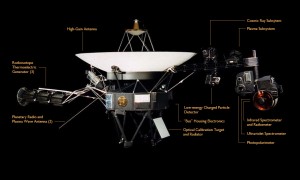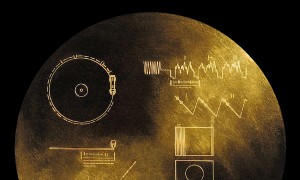Voyager: To the Edge of the Heliosphere & Beyond
If you’re in DC this week, NASA has a treat planned for anyone and everyone steeped in NASA mission history. Thursday, April 28 NASA will present The Voyager Spacecraft Humanity’s Farthest Journey from 1-2 pm ET in NASA HQ auditorium. The event is open to the public and will also be broadcast on NASA TV.You’re invited to hear the 33 year journey of NASA’s twin Voyager spacecraft which have explored space where nothing (including man) has flown before. Both spacecrafts are still going strong and have reached the outer boundaries of the Heliosphere. Voyager 1 and 2 have given us a close look at Jupiter, Saturn, Uranus, and Neptune as well as the outer boundaries of our Solar System that we might not have seen until sometime in the future without their keen eyes.
As Voyager heads beyond our Solar System, a golden record is aboard carrying the sounds, culture, and voices of Earth’s diverse cultures. The recording, a project lead by Carl Sagan, is a snapshot of a diverse planet Earth with messages of welcome and peace in 55 languages.
The plan is when Voyager encounters extraterresterial life in the future, they will have the technology to play the record and discover all the wonderful things about Earth! While we’ve progessed a measurable amount since the recording was made, it still remains a symbol of who we were and what humanity was in 1977.The record is a time capsule, a metaphor, a ‘message in a bottle’ so to speak. Imagine those of us who monitor space listening for signs of intelligent communication coming from ‘out there in space’ finally getting the call with references back to information on the golden record!
While not a full fledged Trekkie, I love the science and the technological advancements found in Star Trek. As a writer, I do believe that ideas can shape the world and our future as the seed of an idea can be planted and grown through a process of scientific development into future technologies. After all, ideas drive the process of innovation and invention. As a child, I thought by the time I grew up we would have starships, warp drive, renewable energy to power spacecrafts (Dilithium Crystals), space colonies, transporters, and oh so much more.
I still remember the first Star Trek movie where an alien ship named V’Ger attacks the Enterprise and abducts a crew member. As Kirk and his crew dig deeper into the origins of the alien spacecraft, Spock discovers the alien ship is actually Voyager 6, a 20th century space probe that was discovered by an alien race of living machines and based on its recorded message, is sent on a mission to learn all it can and find its creator. Along the way V’Ger gathers so much knowledge that it achieves conciousness. Fascinating. We all know what happens when machines can think for themselves.
While this storyline has since been adopted and made into other movies, Terminator and the Matrix. As their journey continues, we can only imagine where their destiny will take them. Along the way, we’ll continue to follow their path ever hopefuly that one day those extraterristerals will ping us back and say hi.





